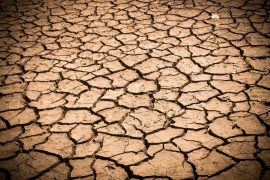In late January 2012, I found myself in a tiny car driving up Black Mountain. Black Mountain is in southeastern Kentucky on the border with Virginia, and is known for its black bears, cougars, and coal. It is also the highest peak in Kentucky. As I drove up that mountain, the January fog got thicker and thicker, and I was worried that I wouldn’t be able to see anything but clouds at the peak. Up and up and up I drove, around breakneck bends with no guardrail on the side. Up and up and up I drove, until I rounded the last bend and pulled over into a gravel parking area.
What I saw when I stepped out of the car made me weep.
What I could see over the border into Virginia was Mountain Top Removal. Mountaintop removal is the process of using dynamite to blast off the top ridge of a mountain to expose coal seams; in many places it is used instead of deep underground mining. The phrase “laid waste” took on a new meaning. Where there were supposed to be endless parallel ridges of Appalachian glory, there lay only the long ropy scars from the naked coal seams. Where there had been vast forests, there lay pits excavated by dynamite blasts. Where there had been a skyline that humans had borne witness to over thousands of years, there lay only the flat triumph of human power and greed over the breadth and beauty of God’s creation.
This sight moved me deeply. Black Mountain was also in line for Mountain Top Removal.
Right there on that mountain, I decided that I could not live in the way that I had been before—namely, in chosen ignorance about the destruction of extractive industries. Standing there in the cold on top of that mountain, I vowed that my children and grandchildren would see mountains. Right there on that mountain, the paradigm in which I saw my life shifted, and I was faced with a choice—to pass by or to act.
Do I have an obligation to help this mountain?
It was a cool and lonely evening as the Samaritan man walked down from Jerusalem to Jericho. The road he walked was known for being dangerous, full of breakneck bends and merciless robbers. The sun had already set and the man was tired from his travels, a merchant heading home to Schechem, a city in Samaria. Down and down and down through the valley he walked, leading his donkey. Down and down and down through the valley he walked, until he turned his head and looked to the side of the road.
What he saw in the roadside ditch made him pause.
Just visible in the ditch beside the road was a human figure who had evidently been brutally beaten, lying naked, exposed to the elements. The person’s face was bruised and bloodied, barely recognizable. No clothing or identification or possessions accompanied the man, who had been robbed of all he must have carried with him, valuable or invaluable, on this dangerous road. Only long ropy scars marked this man’s back.
This sight moved the traveler deeply. He also knew the despair of being robbed of his dignity, of living in a world of oppression, and of being seen as unworthy of anyone’s assistance because of the walls people set up between each other.
Right there on that road, the traveler had to make a decision. What if this person was a Jew? What if he didn’t want to be helped, seeing only danger hovering above him in the form of an oppressive Samaritan? What if other Samaritans found out he had shown mercy to a member of a hated ethnic group? What kind of world did he want to leave for his grandchildren?
The traveler didn’t even know that he was not the first person to pass by the man in need, that others had seen and not taken action. But that night on that road, he didn’t ask the wounded man’s name or country or station before he tended the man’s injuries. Instead, he decided to offer an extravagant grace, a radical hospitality, in caring for someone in need by virtue of them being a fellow Creation of God.
Who is my neighbor?
In the conversation between Jesus and the lawyer at the beginning of this passage, Jesus does something really cool. The lawyer, like many of us today, is looking for instant gratification; he simply wants to know how to gain eternal life by doing something simple, by crossing something off his to-do list. He is wondering, “Whom must I treat as a friend? Whom do I have an obligation to help? How far do the limits of my responsibility extend? Where can I draw my borders?”
Jesus, however, turns these questions around, asking, “Who in the story acted as a friend?” He includes action in his rephrasing, changing the conversation to one about verbs—gaining eternal life is not about believing one thing, but it must be combined with actions. In this back-and-forth, “Jesus changes the definition of neighbor from one who is the object of kindness (in need and receiving the compassion and mercy) to one who bestows it.” There is mutuality in the word “neighbor”: it is a two-way street of loving “your neighbor as yourself.”
Many of us are good at this. We volunteer in soup kitchens, deliver water to people whose water is contaminated, donate clothes to the needy, visit folks in prison, and (sometimes) we even welcome the stranger. Jesus does not only expect us to bless others with our privilege as a community service project, but he paints a picture of a society in which there is mutual benefit from assisting and accepting assistance from each other. Scholar Amy-Jill Levine recalls Martin Luther King, Jr.’s interpretation of this parable: “[King] said something like: ‘I don’t know why [the priest and the Levite] walked by the man in the ditch, but here’s what my imagination tells me. Perhaps these men were afraid. The priest and the Levite say to themselves, “If I stop to help this man, what will happen to me? There are bandits on the road.” And the Samaritan says, “If I do not stop to help this man, what will happen to him?” So the Samaritan asked the right question.’ King goes on to say: If I don’t stop to help the sanitation workers in Memphis, what will happen to them?’ And we know what happened to King.”[ref]“A Jewish take on Jesus: Amy-Jill Levine talks the gospels,” U.S. Catholic, October 2012. Accessed March 1, 2015. http://www.uscatholic.org/church/2012/09/jewish-take-jesus-amy-jill-levine-talks-gospels#sthash.TPIKotyW.dpuf.[/ref]
So, no more can we view ourselves simply as the givers and distributors of aid. No more can we simply view ourselves as waiting for someone to haul us out of the ditch and fix the world for us. And certainly, no more can we wear our tunnel vision through our lives, missing the stranded travelers and people in need along our path. Gaining eternal life is living into a beloved community over time—being a “neighbor” is an ongoing process of being fully engaged and committed to community. The parable of the Good Samaritan is not a simple story about just one person showing compassion to one other person in need. It is about different ways of being in a community, and how we should treat each other as neighbors.
How would our lives be different if a mountain was our neighbor?
Knowing what we know about human-induced climate change, we cannot continue to pass by on the other side of the road. No matter how much differing views say humans contribute to environmental issues, if we are part of the problem, then we can also (and should also) be part of the solution. We cannot continue to think that recycling our plastic-ware and planting a tree every Arbor Day are going to fix everything. We cannot watch the Appalachian economy suffer while coal companies shut down, without having another solution ready. We cannot watch people going hungry when there is enough healthy food in the world and not do anything. There must be an action enacted so that we can truly be neighbors to our fellow created beings. How far does our responsibility extend? Whom and what must we love in order to be true neighbors?
Philosopher William James writes, “We are like islands in the sea, separate on the surface but connected in the deep.”[ref]James, William. “The confidences of a ‘physical researcher.’” American Magazine, October 1909.[/ref] Though humans find many reasons to separate ourselves from each other and from nature, we must realize that we are all part of the same Creation, the same dream of God. Environmental justice is not just about saving a tree for a tree’s sake, but it is about the health and wholeness of all the beings that share this planet. It stretches across race, class, gender, sexuality, geographical location and even time. Many indigenous cultures emphasize understanding all actions we do as affecting the world even to the 7th generation from now. All things—you, me, a tree, water, animals—we were all formed intimately by God’s own hands, raised out of the dust and given the breath of life. And God loves us extravagantly. It is our job to reflect that love back—around our neighborhoods, in our communities, and throughout the whole world.
Right here and right now, I challenge you to live into a beloved community of creation. Support school gardens. Help reduce your church’s waste. Listen to children’s stories. Get to know your neighbors. Share a meal with friends. Witness the season’s change. Reflect the extravagant grace and hospitality that God showed the world—even to the 7th generation.
The radical hospitality that the Good Samaritan showed the Jew lying in the ditch—that Jesus showed the Earth by coming to us incarnate in human flesh—that radical hospitality is the cornerstone of a community that upholds justice and love of neighbor—that radical hospitality is the cornerstone of the Kingdom of God, the community of all Creation.
Theologian Sallie McFague writes, “Once the scales have fallen from one’s eyes, once one has seen and believed that reality is put together in such a fashion that one is profoundly united to and interdependent with all other beings, everything is changed. One has a sense of belonging to the earth, having a place in it along with all other creatures, and loving it more than one ever thought possible.” [ref]McFague, Sallie. “A Square in the Quilt: One Theologian’s Contribution to the Planetary Agenda.” In Spirit and Nature: Why the Environment is a Religious Issue–An Interfaith Dialogue, edited by Stephen C. Rockefeller and John Elder, 39-58. Boston: Beacon Press, 1992.[/ref]
Imagine you are traveling up a mountain. The air is cool. You see your surroundings clearly—every rock, tree, animal, and person gets your attention. You see the homeless person and the river contaminated with coal dust. You see the endangered woodpecker and the children living in food deserts. You see the mountains lying naked, scarred from demolition—their dignity ripped away by extractive industries’ violation. What do you see? What do you do? What kind of world do you want to leave your grandchildren?





